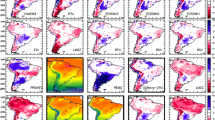Abstract
The regional climate change index (RCCI) is employed to investigate hot-spots under 21st century global warming over East Asia. The RCCI is calculated on a 1-degree resolution grid from the ensemble of CMIP3 simulations for the B1, A1B, and A2 IPCC emission scenarios. The RCCI over East Asia exhibits marked sub-regional variability. Five sub-regional hot-spots are identified over the area of investigation: three in the northern regions (Northeast China, Mongolia, and Northwest China), one in eastern China, and one over the Tibetan Plateau. Contributions from different factors to the RCCI are discussed for the sub-regions. Analysis of the temporal evolution of the hot-spots throughout the 21st century shows different speeds of response time to global warming for the different sub-regions. Hot-spots firstly emerge in Northwest China and Mongolia. The Northeast China hot-spot becomes evident by the mid of the 21st century and it is the most prominent by the end of the century. While hot-spots are generally evident in all the 5 sub-regions for the A1B and A2 scenarios, only the Tibetan Plateau and Northwest China hot-spots emerge in the B1 scenario, which has the lowest greenhouse gas (GHG) concentrations. Our analysis indicates that subregional hot-spots show a rather complex spatial and temporal dependency on the GHG concentration and on the different factors contributing to the RCCI.
Similar content being viewed by others
References
Baettig, M. B., M. Wild, and D. M. Imboden, 2007: A climate change index: Where climate change may be most prominent in the 21st century. Geophys. Res. Lett., 34, L01705.
Christensen, J. H., and Coauthors, 2007: Regional climate projections. Climate Change 2007: The Physical Science Basis. Contribution of WGI to the IPCC AR4, Solomon et al., Eds., Cambridge University Press, Cambridge, United Kingdom and New York, NY, USA, 847–940.
Giorgi, F., 2006: Climate change hot-spots. Geophys. Res. Lett., 33, L08707, doi: 10.1029/2006GL025734.
Giorgi, F., and X. Q. Bi, 2005: Updated regional precipitation and temperature changes for the 21st century from ensembles of recent AOGCM simulations. Geophys. Res. Lett., 32, L21715, doi: 10.1029/2005GL024288.
Giorgi, F., J. W. Hurrell, M. R. Marinucci, and M. Beniston, 1997: Elevation signal in surface climate change: A model study. J. Climate, 10, 288–296.
Giorgi, F., and Coauthors, 2001: Emerging patterns of simulated regional climatic changes for the 21st century due to anthropogenic forcings. Geophys. Res. Lett., 28, 3317–3320.
Gong, D. Y., and C.-H. Ho, 2002: Shift in the summer rainfall over the Yangtze River valley in the late 1970s. Geophys. Res. Lett., 29(10), 1436, doi: 10.1029/2001GL014523.
Hu, Z. Z., S. Yang, and R. Wu, 2003: Long-term climate variations in China and global warming signals. J. Geophys. Res., 108(D19), 4614, doi: 10.1029/2003JD003651.
IPCC, 2000: Special Report on Emissions Scenarios. Nakicenovic et al., Eds., Cambridge University Press, Cambridge, 612pp.
IPCC, 2007: Climate Change 2007: The Physical Science Basis. Contribution of WG1 to the IPCC AR4, Solomon et al., Eds., Cambridge University Press, Cambridge, United Kingdom and New York, NY, USA, 996pp.
Jiang, D., and H. J. Wang, 2005: Natural interdecadal weakening of East Asian summer monsoon in the late 20th century. Chinese Science Bulletin, 50(17), 1923–1929.
Jiang, D., H. J. Wang, and X. Lang, 2004: East Asian climate change trend under global warming background. Chinese Journal of Geophysics, 47(4), 590–596.
Meehl, G. A., and Coauthors, 2007: Global climate projections. Climate Change 2007: The Physical Science Basis. Contribution of WGI to IPCC AR4, Solomon et al., Eds., Cambridge University Press, Cambridge, United Kingdom and New York, NY, USA, 747–845.
New, M. G., M. Hulme, and P. D. Jones, 2000: Representing twentieth century space time climate fields. Part II. Development of a 1901–1996 mean monthly terrestrial climatology. J. Climate, 13, 2217–2238.
Räisänen, J., 2002: CO2-induced changes in interannual temperature and precipitation variability in 19 CMIP2 experiments. J. Climate, 15, 2395–2411.
Randall, D. A., and Coauthors, 2007: Climate models and their evaluation. Climate Change 2007: The Physical Science Basis. Contribution of WGI to IPCC AR4, Solomon et al., Eds., Cambridge University Press, Cambridge, United Kingdom and New York, NY, USA, 589–662.
Seneviratne, S. I., D. Lüthi, M. Litschi, and C. Schär, 2006: Land-atmosphere coupling and climate change in Europe. Nature, 443(14), 205–209.
Wang, H. J., 2001: The weakening of the Asian monsoon circulation after the end of 1970’s. Adv. Atmos. Sci., 18, 376–386.
Wang, S.W., D. Y. Gong, and P. M. Zhai, 2002: Observed Climate Changes. Vol. 1, Assessment for Evolution of Environment in Western China, D. H. Qin, Ed., Science Press, Beijing, 29–70. (in Chinese)
Xu, C. H., X. Y. Shen, and Y. Xu, 2007: An analysis of climate change in East Asia by using the IPCC AR4 simulations. Advances in Climate Change Research, 3(5), 287–292. (in Chinese with English Abstract)
Yu, R. C., and T. J. Zhou, 2007: Seasonality and three-dimensional structure of the interdecadal change in East Asian monsoon. J. Climate, 20, 5344–5355.
Zhai, P. M., A. J. Sun, F. M. Ren, X. N. Lin, B. Gao, and Q. Zhang, 1999: Changes of climate extremes in China. Global and Planetary Change, 42, 203–218.
Zhai, P. M., X. B. Zhang, H. Wang, and X. H. Pan, 2005: Trends in total precipitation and frequency of daily precipitation extremes over China. J. Climate, 18, 1096–1108.
Zhao, Z. C., X. J. Gao, M. C. Tang, and Y. Xu, 2002: Climate Change Projections. Vol. 2, Assessment for Evolution of Environment in Western China, D. H. Qin, Eds., Science Press, Beijing, 16–46. (in Chinese)
Zhou, T. J., and R. C. Yu, 2006: 20th century surface air temperature over China and the globe simulated by coupled climate models. J. Climate, 19(22), 5843–5858.
Author information
Authors and Affiliations
Corresponding author
Rights and permissions
About this article
Cite this article
Xu, Y., Gao, X. & Giorgi, F. Regional variability of climate change hot-spots in East Asia. Adv. Atmos. Sci. 26, 783–792 (2009). https://doi.org/10.1007/s00376-009-9034-2
Received:
Revised:
Published:
Issue Date:
DOI: https://doi.org/10.1007/s00376-009-9034-2




